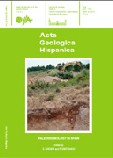Paleoseismic results from multiple trenching analysis along a silent fault: The El Camp fault (Tarragona, northeastern Iberian Peninsula)
Abstract
We present the paleoseismological analysis of the El Camp fault scarp. Paleoseismology constitutes the key methodology for any real estimate of seismic hazard in low-slip-rate areas with no reported historical earthquakes. The recent tectonic activity of this fault is evidenced by a young mountain front and a fault scarp which cuts Quaternary alluvial fans. A regional geological analysis indicates that three generations of alluvial fans are cut by the fault. Absolute (TL and U/Th) and relative datings show that the oldest fan is 300ka old and the intermediate one is 125ka old. The study of 7 trenches and the absolute datings performed (TL, U/Th, radiocarbon as well as pollen analysis) revealed the following: 1) the El Camp fault consists of two segments (the northern end of the southern segment is located close to Porquerola creek); 2) only the southern segment has been active since 125 ka; 3) the fault is seismogenic because it is associated with liquefaction features and colluvial wedges; 4) the El Camp fault has produced at least three well constrained surface-rupturing earthquakes since 125ka (events Z, Y, and X). Based on the different tectonic features observed in the trenches, the recurrence period of large earthquakes during this period was estimated to be around 30ka and the elapsed time to be around 3000yr. Using the fault length and the vertical displacement per event, the largest estimated earthquake had a magnitude of MW 6.7 .


